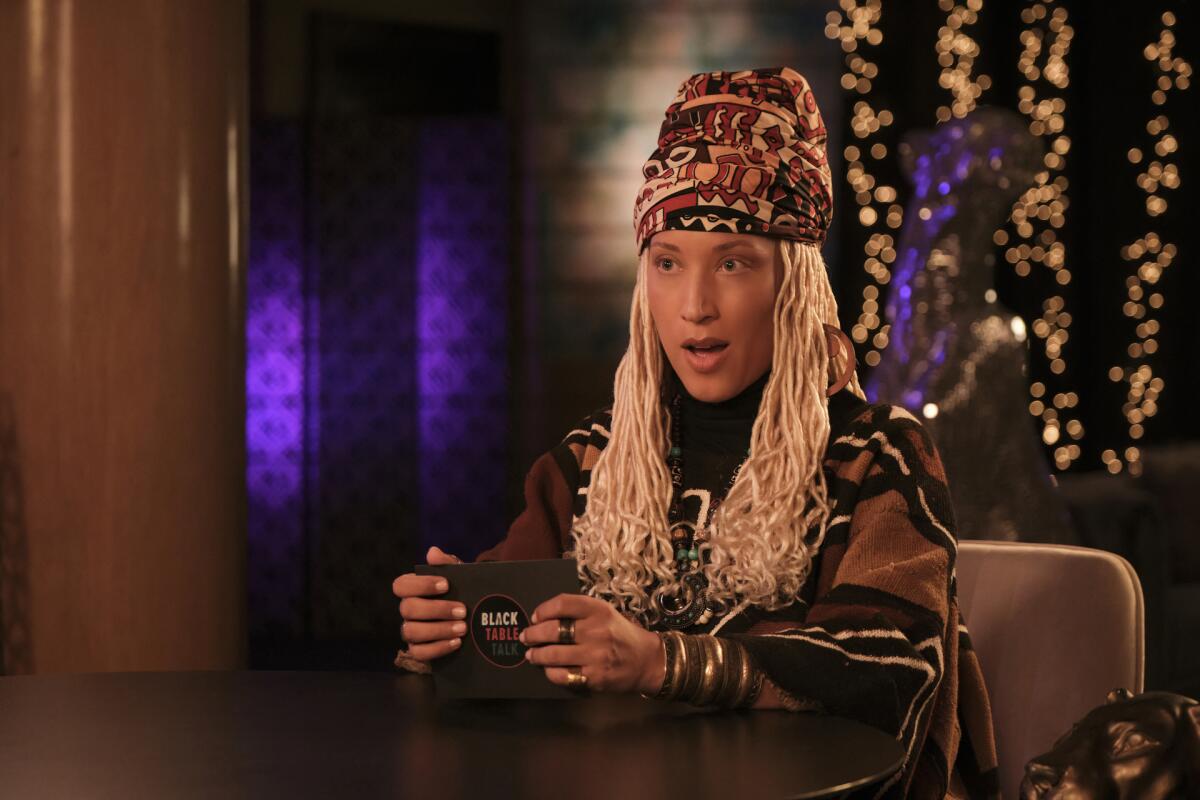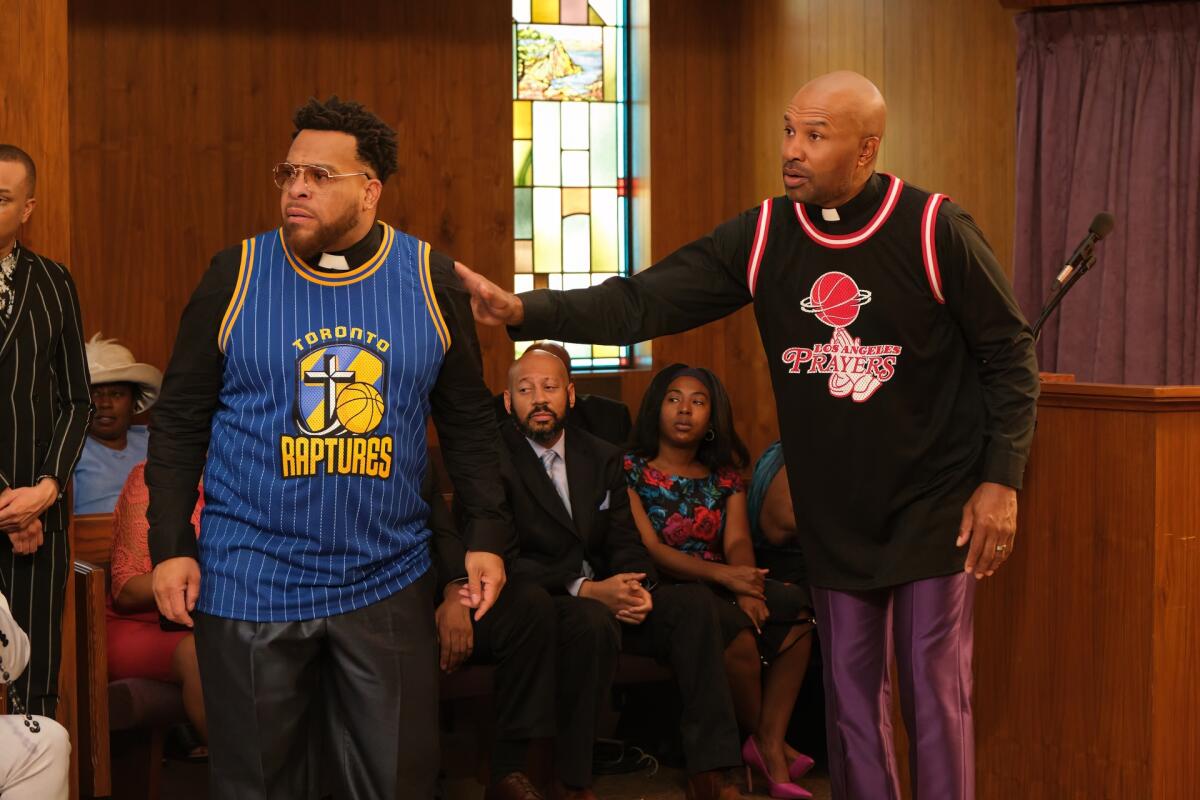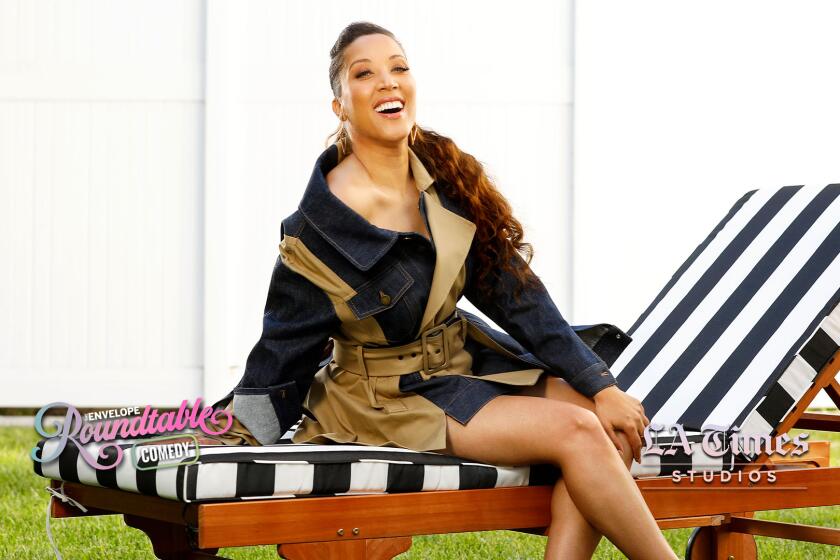‘A Black Lady Sketch Show’ takes lots of improv and holding back laughs, its creator says

- Share via
There is no show on television quite like “A Black Lady Sketch Show.” Now in its fourth season, Robin Thede’s fearless comedy series slices and dices pop culture, race issues, dating woes, feminism, religion and more into 30-minute blasts of fantastically twisted humor.
Co-executive produced by Issa Rae, the show is renowned for pushing the boundaries of the absurd with its cast of featured players Gabrielle Dennis, Skye Townsend, Tamara Jade, DaMya Gurley and Angel Laketa Moore. The show also features weekly guest stars including Rae, Angela Bassett, Sam Richardson and Tracee Ellis Ross. Airing weekly (Episode 5 premieres tonight on HBO), the new season expands upon the madness with such eloquently titled episodes as “Peek-a-Boob, Your Titty’s Out.” We spoke with Thede, television’s first black woman director and black female head writer of a sketch comedy show, about what it takes to bring the show and its litany of characters to life. (One note: This interview took place several weeks before the writers’ strike.)
Thank you for your willingness to break down the anatomy of a sketch, or several sketches.
I will talk about any sketch and tell you all the juicy details, because there’s so many great stories. It’s like shooting a new short film every day with the best guest stars, the best actors, the best writing.
How about “Baptism Runs on Dunkin’” (Episode 2)? It’s structured like an NBA Slam Dunk contest, but the competition is between church deacons. Their goal is to baptize the most babies in a quarter, and the “game” is replete with a court, hoop and commentators.
“Baptism Runs on Dunkin’” is hysterical and disturbing. Once you get over the shock of what’s happening, you get into it. But at first you’re like, WHAT!? The [idea] was from one of our amazing writers who’s also a producer on the show, Corin Wells. We like to merge worlds to create really absurd situations, so she was like, ‘What if it’s the NBA slam dunk contest, but with deacons baptizing babies at church?’ I was like, ‘100% yes, and why does your mind work this way? Let’s go.’

The script was perfect when it came in, but I wanted to get at least one real NBA player in there because I thought that would be hilarious. Our director, Bridget Stokes, her manager is friends with Derek Fisher. We don’t make people audition for the show. We just send offers, so we sent him an offer and he was like yeah, I want to do more stuff like this. I’d also been dying to get Tahir Moore, who’s a famous internet comedian. We like to have a mix, from A-list casting like Angela Bassett and Gabrielle Union to all these amazing internet comedians that we love, like Tahir and KevOnStage.
For the sketch, Chloé Hilliard, who’s one of our co-head writers and a great stand up, had the basketball skills to play pastor Trudyo Werd. Oh, and Kimber Zak [Thede] is back. She’s been around since Season 1. She’s the “famed” announcer who commentates on the everyday life things. And she has a new partner, Skip Appeal, a church lady who’s very saved and sanctified.
The setup is ambitious. A basketball court in a church, a choir, bleachers.
I remember Derek saying, ‘Do you guys get to have this much fun every day?’ We were like, yes! Tahir lost his voice from singing with the choir. Chloé was pulling out crazy dunks. That sketch is really indicative of the fun we have on the show because it was so physical and so big. We had to make a custom basketball hoop that was big enough for people to dunk, but also short enough that they weren’t going to get injured. And we had all these different cameras going because we wanted it to have the energy of an NBA slam dunk contest. To lay it out like a basketball court, we built the church pews up like bleachers. And I don’t know if this is blasphemous, but we shot it in a funeral home.

Kimber is one of many recurring characters on the series.
Somebody called me the queen of callbacks earlier, which I love. When I created the show, I wanted to have narrative sketches where we follow these characters and see how they grow, and hear their backstories, and really get you to know them. I think that’s why people have their favorite characters.
“My happy ending is her happy ending.”
Which brings us to “What Up, I’m Three” and your character, Annie. She’s an adult whose impersonating a chil,d and her mother (Townsend) has no clue that she’s raising a con artist. Annie always has an angle.
I love playing Annie. She was a character that I tried to do for years but my writers were like, You’re crazy! That character makes no sense. But I found a way to do it. She was [inspired by] this story about a U.K. couple that adopted a girl who they thought was 5 but she was like 20, and getting her period. Now Annie is trying to enroll in kindergarten because she needs a new scam.

There’s an actual child in the sketch (Episode 2) who plays a prospective student. Did you do a child casting call?
I hate auditions. We’ve only ever had like two for the show. I definitely didn’t want to call a bunch of girls in for this. So I thought, my niece can do this! And everybody’s like, has she ever acted? No, she’d be a nepo baby. But I knew she would be good, and she was. Plus I knew I could boss her around and get what we wanted out of her, so it was really fun. Angel Laketa Moore plays her mom. I told her to just go out there and be that overbearing mom. Go crazy. And she did. It was actually a bit triggering.
One of my favorite sketches is “Black Table Talk” with its host, the “world-renowned philosophizer” Dr. Hadassah Olayinka Ali-Youngman, pre-PhD. This season, she interviews “Euphoria’s” Colman Domingo, and it’s brilliant. How did that happen?
Colman and I are friends, so I wrote a script for him. We don’t usually write scripts for celebrities, but because he’s playing this hyper-realized version of himself, I wrote a script specifically for him. I wanted her to go head to head with a man, which she never really does. I needed somebody who’s a good actor, who can go toe to toe with her and won’t back down. Colman is perfect.

And it truly feels like an unscripted interview.
The scripted version [of the sketch] is like three pages: a basic setup, intro and a couple of the jokes. But after that, we ripped that baby up and we just went. Bridget was sitting two feet from us and I could see her shoulders shaking the whole time. She broke some takes because she was laughing so loud, but he never broke, he never relented.
When I start singing “Wade in the Water,” and he starts harmonizing and he sounds so beautiful, it actually made me laugh. I mean, why would he even join in this? He did such a good balance of fighting me, but also playing along. That’s what it really takes to do that sketch. You can see my back kind of doing this [shaking slightly] and it’s because I’m trying to hold it together. Then there’s the Afro-Latino joke — one of our writers whispered it to me. She said, ask him if he’s Afro-Latino, and where’s Afro-Latinia? Seventy percent of what you see was not in the script, and was done in only one take because I don’t believe in redoing. When a joke works in the moment, a second take is never going to work.
Carol Burnett also follows that philosophy, and her sketch comedy is timeless.
Carol Burnett was a massive influence. Watching her variety show, you could tell they’re capturing something that they’ll never get again. There’s a sketch she did with Robin Williams that is a master class in improvisation. Their brains are going at lightning speed. They ping-pong off each other. It’s just unbelievable. And the cool thing about it is that when they did break, which was very rare, it was fun. It popped the bubble in a fun way.
But we don’t break on the show, at least that the audience will see, but I think it’s obvious when we’re on the edge of it. We have the advantage of editing the show for months and figuring out how to craft each moment, but we don’t do it so much that that spontaneity is lost. We leave room [for audiences] to play the game of Was It Improv or Scripted? People would be shocked because there are so many moments that were improvised moment, that never hit a piece of paper.
A great example of improv is with the character Chris (Thede), who returns to the fold in the Episode 4 sketch, “Spacing Out.” He’s incapable of answering “yes” or “no” in critical situations. Then when pressed, he’s a font of nonsensical word association. “Yes” turns into “yerp,” “yeti” and “yellow.”
I was excited to have Chris back. He’s complicated, but he’s also a [boy toy]. We haven’t seen him since Season 2 and he now has a much improved hairline. We actually pulled in a barber who does all the men in Hollywood. We definitely go off script in that sketch, as we do with a lot of sketches. But with Chris, sometimes it can be a 17-minute take. I’ll know what the run is going to be: say a bunch of “Y” words, and then, a bunch of “M” words, so I’ll go and go and go. The writers will also have a list ready, and so they’ll just read out like 10 more, and I’ll use the ones I like. So it’s the script, getting thrown live jokes as we’re as we’re shooting and me improvising. The crew is just dying because they don’t know what’s going to come out of my mouth. I know when I see the boom [mic] dip, it’s like because [the operator] is doubled over laughing. My job is just to break whoever is around me.

Even more impressive are the totally scripted moments that feel spontaneous.
Yes. It’s a testament to the acting when people think scripted jokes are improvised. That’s great acting. Comedians don’t get enough credit for how hard the work of the acting is. We put on a new persona every day and make you believe it, all to make you laugh.
'A Black Lady Sketch Show'
Where: HBO Max
When: Any time
Rating: TV-MA (may be unsuitable for children under the age of 17)
More to Read
The complete guide to home viewing
Get Screen Gab for everything about the TV shows and streaming movies everyone’s talking about.
You may occasionally receive promotional content from the Los Angeles Times.









